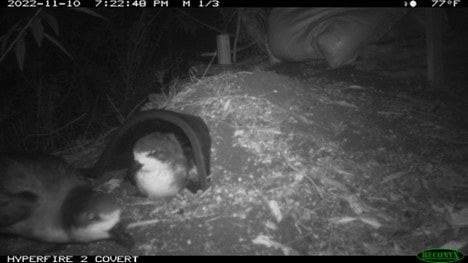
Predator-proof fencing
To combat invasive predators and plants, an eight acre predator-free area (Nihoku) was created at Kilauea Point National Wildlife Refuge in 2014 by constructing a predator-proof fence and removing all mammalian predators from inside of it. The fence is tall enough to prevent animals from jumping over, has a hood to prevent them from climbing, mesh that is small enough even mice can’t squeeze through and has a skirt underground that prevents them from digging in. All of the materials are marine grade stainless steel to ensure it lasts in the harsh coastal environment.
Left: Habitat restoration at Nihoku. Right photo: Artificial burrow designed for nesting seabirds
Habitat restoration
To restore the habitat inside the fence, invasive plants were removed and more than 10,000 native plants representing 30 species have been outplanted to date . Plants were chosen that were not only adapted for the harsh coastal ecosystem but provided food for Nene and cover for nesting seabirds. Each year one acre is restored so that over time, the entire enclosure will ultimately be comprised of native plants. To encourage seabirds to nest in the area, 50 artificial burrows were installed to provide nesting habitat for the seabirds.
Below: video on habitat restoration at Nihoku
To combat invasive predators and plants, an eight acre predator-free area (Nihoku) was created at Kilauea Point National Wildlife Refuge in 2014 by constructing a predator-proof fence and removing all mammalian predators from inside of it. The fence is tall enough to prevent animals from jumping over, has a hood to prevent them from climbing, mesh that is small enough even mice can’t squeeze through and has a skirt underground that prevents them from digging in. All of the materials are marine grade stainless steel to ensure it lasts in the harsh coastal environment.
Left: Habitat restoration at Nihoku. Right photo: Artificial burrow designed for nesting seabirds
Habitat restoration
To restore the habitat inside the fence, invasive plants were removed and more than 10,000 native plants representing 30 species have been outplanted to date . Plants were chosen that were not only adapted for the harsh coastal ecosystem but provided food for Nene and cover for nesting seabirds. Each year one acre is restored so that over time, the entire enclosure will ultimately be comprised of native plants. To encourage seabirds to nest in the area, 50 artificial burrows were installed to provide nesting habitat for the seabirds.
Below: video on habitat restoration at Nihoku
Below: video describing seabird artificial burrows put in at Nihoku

Seabird social attraction and translocation
The final phase of the Nihoku Ecosystem Restoration Project has been translocating and attracting threatened seabirds (Newell's Shearwater and Hawaiian Petrels) into the area. This is done in two ways- social attraction relies on broadcasting their calls from two large speakers to ‘call them in’ and encourage adult birds to nest. Second, chicks that have not yet left their burrows in the mountain colonies are translocated to the site, and cared for at Nihoku until they fly out to sea for the first time. By choosing chicks who have not yet emerged from their mountain burrows, we ensure that they imprint on Nihoku by observing the night sky there. The first Hawaiian Petrel chicks were translocated to the site in 2015, and the first Newell's Shearwater chicks were moved in 2016 and translocations continued until 2020 for both species. In total 86 ‘A‘o and 106 ‘Ua‘u fledged from Nihoku, and one ‘A‘o and eight ‘Ua‘u have returned as adults. We currently have three breeding pairs of ‘Ua‘u.
Left: Newell's Shearwater chick in pet carrier being removed from it's mountain burrow on translocation day
Right: Newly translocated Hawaiian Petrel chicks at Nihoku
The final phase of the Nihoku Ecosystem Restoration Project has been translocating and attracting threatened seabirds (Newell's Shearwater and Hawaiian Petrels) into the area. This is done in two ways- social attraction relies on broadcasting their calls from two large speakers to ‘call them in’ and encourage adult birds to nest. Second, chicks that have not yet left their burrows in the mountain colonies are translocated to the site, and cared for at Nihoku until they fly out to sea for the first time. By choosing chicks who have not yet emerged from their mountain burrows, we ensure that they imprint on Nihoku by observing the night sky there. The first Hawaiian Petrel chicks were translocated to the site in 2015, and the first Newell's Shearwater chicks were moved in 2016 and translocations continued until 2020 for both species. In total 86 ‘A‘o and 106 ‘Ua‘u fledged from Nihoku, and one ‘A‘o and eight ‘Ua‘u have returned as adults. We currently have three breeding pairs of ‘Ua‘u.
Left: Newell's Shearwater chick in pet carrier being removed from it's mountain burrow on translocation day
Right: Newly translocated Hawaiian Petrel chicks at Nihoku
Below: First ever wild Hawaiian Petrel chick and it's parent at Nihoku in November 2022
|
|
Contact us: Nihoku Ecosystem Restoration Project c/o Pacific Rim Conservation PO Box 61827 Honolulu, HI, 96839 E-mail: [email protected] This website is owned and managed by Pacific Rim Conservation |
